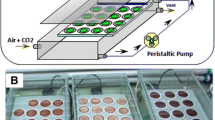Summary
The environmental conditions prevailing in Israel make marine algae an attractive crop for the production of valuable chemicals. A marine species of Porphyridium seems to fit this purpose.
The unicellular red alga Porphyridium is encapsulated by a polysaccharide envelope that is present in the gel state. This polysaccharide is an acidic heteropolymer composed of sulfated sugars. It forms ionic bridges through divalent cations, thus reaching a very high molecular weight. The thickness of the polysaccharide capsule varies according to the phase of growth and the growth conditions. Its outer part dissolves in the growth medium, which becomes progressively more viscous. Sulfated polysaccharides form theramlly reversible gels similar to agar and carrageenan, which are usually extracted from marine macroalgae. These gels have been finding increasing use in commercial applications as gelling agents, thickeners, stabilizers, and emulsifiers.
We have done experiments on the cultivation of a marine species of Porphyridium for the production of polysaccharides. This unicellular alga has an advantage over the macroalgae due to its relatively faster growth rate and the possibility to regulate its growth. The potential for production of the polysaccharide, both that dissolved in the external medium and that attached to the cell (including an intracellular fraction), and the effects of growth conditions on productivity were suudied in the laboratory. Porphyridium was also cultivated outdoors in seawater in 1-m2 ponds and its growth potential investigated.
Similar content being viewed by others
References
Colegrove G T 1983 Agricultural applications of microbial polysaccharides. Ind. Eng. Chem. Prod. Res. Dev. 22, 456–460.
Gant E and Conti S F 1965 The ultrastructure ofPorphyridium cruentum. J. Cell Biol. 26, 365–381.
Jones R F Speer H L and Kury W 1963 Studies on the growth of the red algaePorphyridium cruentum. Physiol. Plant. 16, 636–643.
Ramus J 1972 The production of extracellular polysaccharide by the unicellular red algaPorphyridium aerugineum. J. Phycol. 8, 97–111.
Ramus J 1976 Cell surface polysaccharide of the red alga Porphyridium. Plant Cell Wall Polysaccharides. p 333.
Ramus J 1977 Alcian Blue: a quantitative aqueous assay for algal acid and sulfated polysaccharides. J. Phycol. 13, 345–348.
Ramus J 1980 Algae Biopolymer Production. US Patent No. 4, 236, 349.
Ramus J and Groves S T 1974 Precursor-product relationship during sulfate incorporation into Porphyridium capsular polysaccharide. Plant Physiol. 53, 434–439.
Ramus J and Robins D 1975 The correlation of Golgi activity and polysaccharide secretion in Porphyridium. J. Phycol. 11, 70–74.
Shelef G and Soeder C J Eds. 1981 Algal Biomass: Production and Use. Elsevier/North-Holland, Amsterdam.
Author information
Authors and Affiliations
Rights and permissions
About this article
Cite this article
Arad, S.(., Adda, M. & Cohen, E. The potential of production of sulfated polysaccharides from Porphyridium. Plant Soil 89, 117–127 (1985). https://doi.org/10.1007/BF02182238
Issue Date:
DOI: https://doi.org/10.1007/BF02182238




